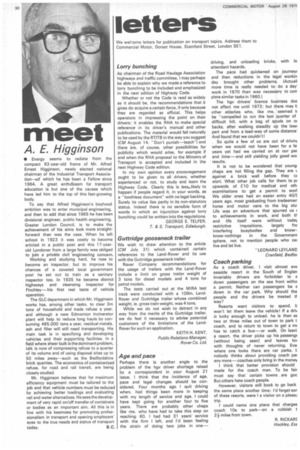A. E. Higginson
Page 32

If you've noticed an error in this article please click here to report it so we can fix it.
• Energy seems to radiate from the compact 63-year-old frame of Mr. Alfred Ernest Higginson, newly elected national chairman of the Industrial Transport Association—.of which he has been a Fellow since 1964. A great enthusiasm for transport education is but one of the causes which have led him to the top of this fast-growing body.
To say that Alfred Higginson's boyhood ambition was to enter municipal engineering, and then to add that since 1965 he has been divisional engineer, public health engineering. Greater London Council, is to make the achievement of his aims look more straightforward than was the case. When he left school in 1923 it was costly to become articled in a public post and this 17-yearold Londoner from a large family was obliged to join a private civil 'engineering concern.
Working and studying hard, he rose to become an inspector, but to improve his chances of a coveted local government post he set out to train as a sanitary inspector too. In 1935 he became district highways and cleansing inspector for Finchley—his first real taste of vehicle operation.
The GLC department in which Mr. Higginson works has, among other tasks, to clear 3m tons of household and trade refuse a year, and although a new Edmonton incinerator plant will help to reduce long hauls by consuming 485,000 tons a year, residual metals. ash and filler will still need transporting. His main task is in specifying and developing vehicles and their supporting facilities. In a field where sheer bulk is the dominant problem, talk is now of compressing refuse to a quarter of its volume and of using disposal sites up to 50 miles away—such as the Bedfordshire brick quarries. The economics of containerized refuse, for road and rail transit, are being closely studied.
Mr. Higginson believes that for maximum efficiency equipment must be tailored to the job and that vehicle numbers must be reduced by achieving better loadings and evaluating rail and water alternatives. He sees the development of very rapid on/off transfer of containers or bodies as an important aim. All this is in line with his keenness for promoting professionalism in transport and opening employers' eyes to the true needs and status of transport
today. B.C.
































































































